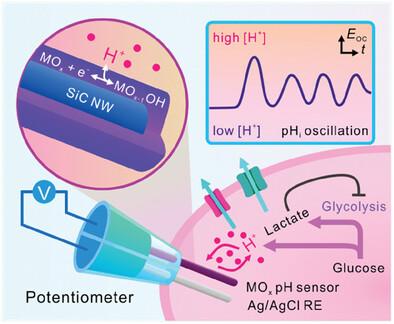Reference-Attached pH Nanosensor for Accurately Monitoring the Rapid Kinetics of Intracellular H+ Oscillations
IF 13
2区 材料科学
Q1 CHEMISTRY, MULTIDISCIPLINARY
引用次数: 0
Abstract
Intracellular pH (pHi) is an essential indicator of cellular metabolic activity, as its transient or small shift can significantly impact cellular homeostasis and reflect the cellular events. Real-time and precise tracking of these rapid pH changes within a single living cell is therefore important. However, achieving high dynamic response performance (subsecond) pH detection inside a living cell with high accuracy remains a challenge. Here a reference-attached pH nanosensor (R-pH-nanosensor) with fast and precise pHi sensing performance is introduced. The nanosensor comprises a highly conductive H+-sensitive IrRuOx nanowire (SiC@IrRuOx NW) as the intracellular working electrode and a SiC@Ag/AgCl NW as an intracellular reference electrode (RE) to diminish the interferences arising from cell membrane potential fluctuations. This whole-inside-cell detection mode ensures that the entire potential detection circuit is located within the same cell, and the R-pH-nanosensor is able to quantify the mild acidification of cytosol and completely record the fast pH variation within a single cell. It also enables real-time potentiometric monitoring of the pHi oscillations, which synchronize with the glycolysis oscillations in cancer cells. Furthermore, the asymmetry in glycolysis oscillations wave is disclosed and the inhibitory effect of just lactate to glycolysis oscillations is further confirmed.

用于精确监测细胞内 H+ 快速振荡动力学的参考附着 pH 纳米传感器
细胞内 pH 值(pHi)是细胞代谢活动的重要指标,因为它的瞬时或微小变化都会对细胞平衡产生重大影响,并反映细胞事件。因此,实时、精确地跟踪单个活细胞内这些快速的 pH 值变化非常重要。然而,在活细胞内实现高动态响应性能(亚秒级)、高精度的 pH 检测仍然是一项挑战。这里介绍一种具有快速、精确 pHi 传感性能的参考附着式 pH 纳米传感器(R-pH-纳米传感器)。该纳米传感器由对 H+ 敏感的高导电性 IrRuOx 纳米线(SiC@IrRuOx NW)作为细胞内工作电极,SiC@Ag/AgCl NW 作为细胞内参比电极(RE),以减少细胞膜电位波动产生的干扰。这种全细胞内检测模式确保了整个电位检测电路位于同一个细胞内,R-pH 纳米传感器能够量化细胞液的轻度酸化,并完整记录单个细胞内的快速 pH 变化。它还能对 pHi 振荡进行实时电位监测,pHi 振荡与癌细胞中的糖酵解振荡同步。此外,还揭示了糖酵解振荡波的不对称性,并进一步证实了乳酸对糖酵解振荡的抑制作用。
本文章由计算机程序翻译,如有差异,请以英文原文为准。
求助全文
约1分钟内获得全文
求助全文
来源期刊

Small
工程技术-材料科学:综合
CiteScore
17.70
自引率
3.80%
发文量
1830
审稿时长
2.1 months
期刊介绍:
Small serves as an exceptional platform for both experimental and theoretical studies in fundamental and applied interdisciplinary research at the nano- and microscale. The journal offers a compelling mix of peer-reviewed Research Articles, Reviews, Perspectives, and Comments.
With a remarkable 2022 Journal Impact Factor of 13.3 (Journal Citation Reports from Clarivate Analytics, 2023), Small remains among the top multidisciplinary journals, covering a wide range of topics at the interface of materials science, chemistry, physics, engineering, medicine, and biology.
Small's readership includes biochemists, biologists, biomedical scientists, chemists, engineers, information technologists, materials scientists, physicists, and theoreticians alike.
 求助内容:
求助内容: 应助结果提醒方式:
应助结果提醒方式:


